Seneca Falls Convention Worksheets
Do you want to save dozens of hours in time? Get your evenings and weekends back? Be able to teach about the Seneca Falls Convention to your students?
Our worksheet bundle includes a fact file and printable worksheets and student activities. Perfect for both the classroom and homeschooling!
Resource Examples
Click any of the example images below to view a larger version.
Fact File
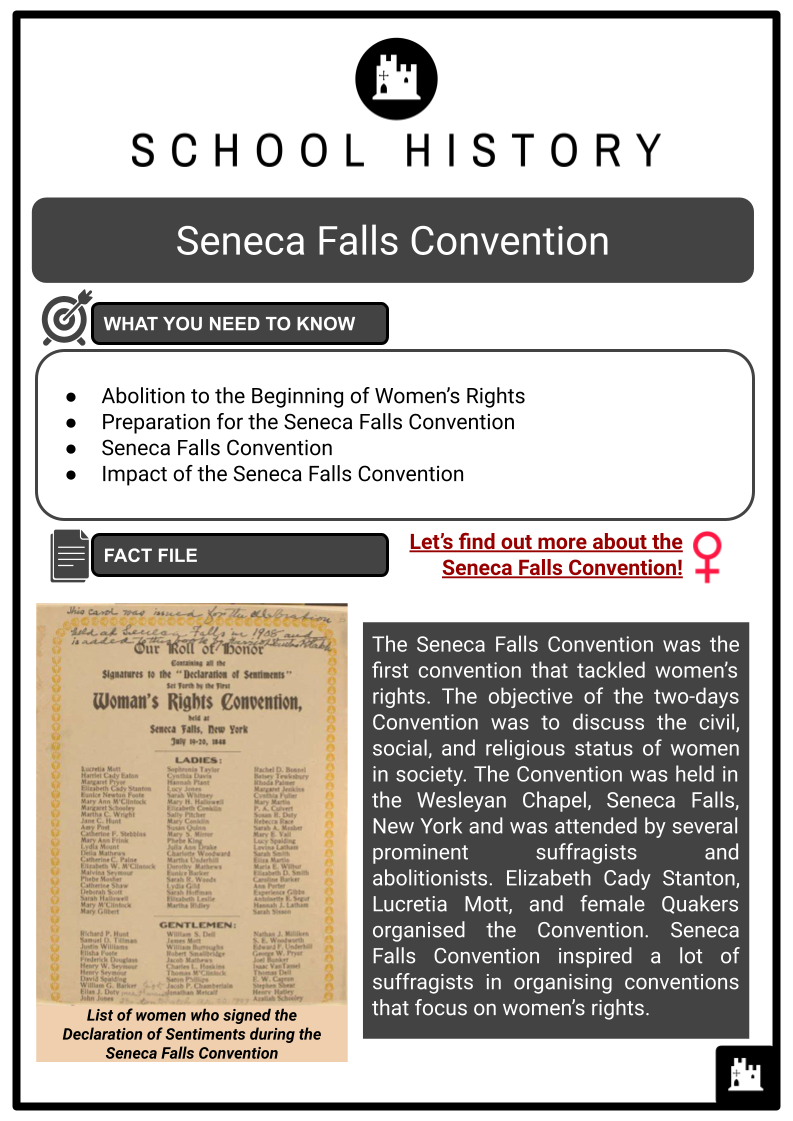
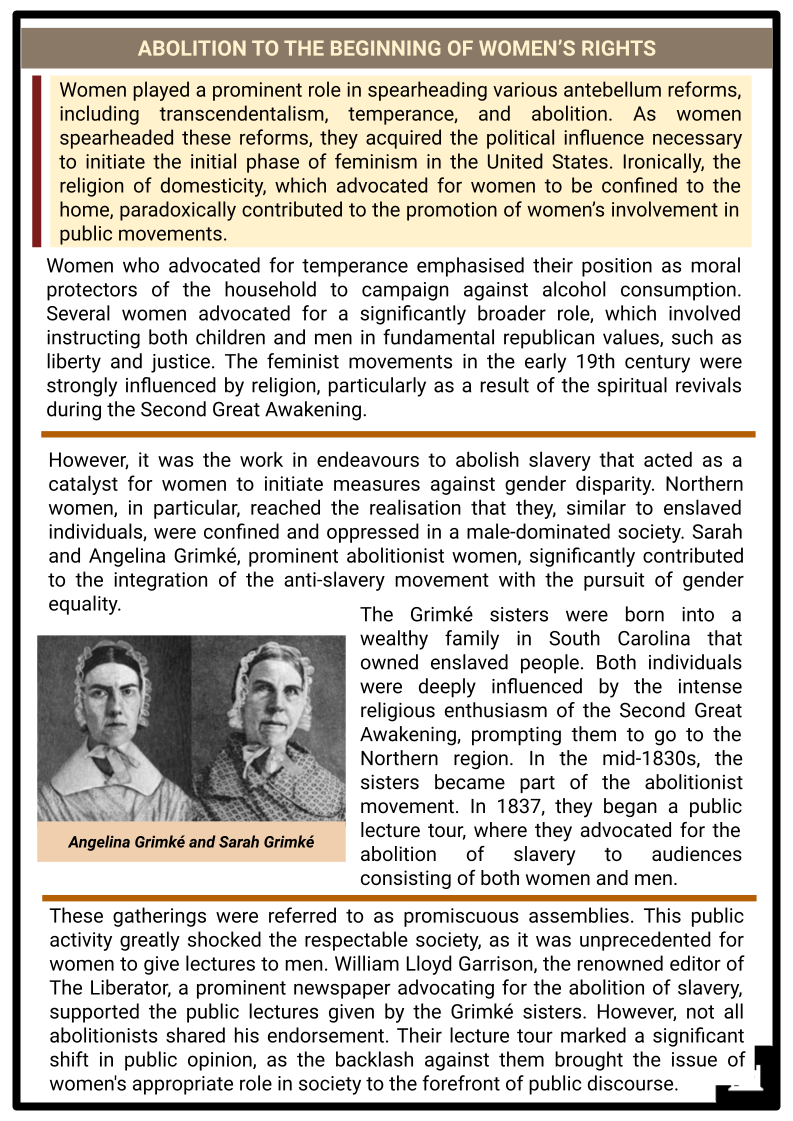
Student Activities
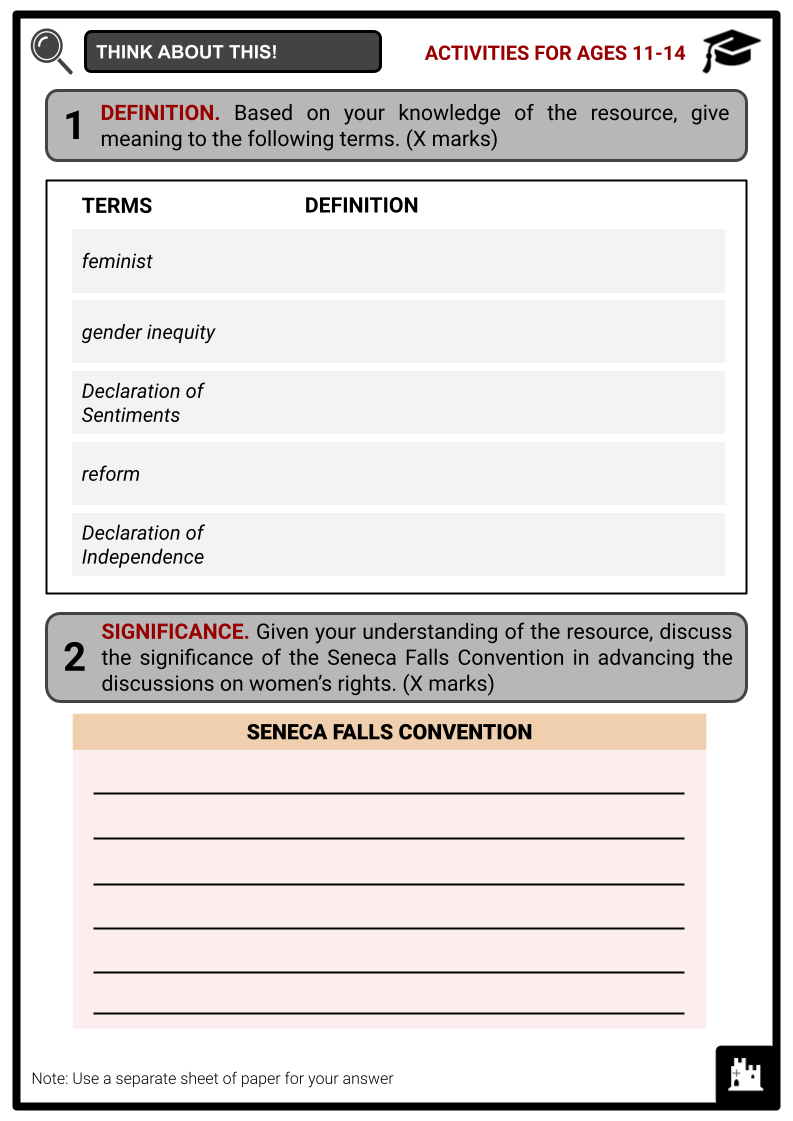
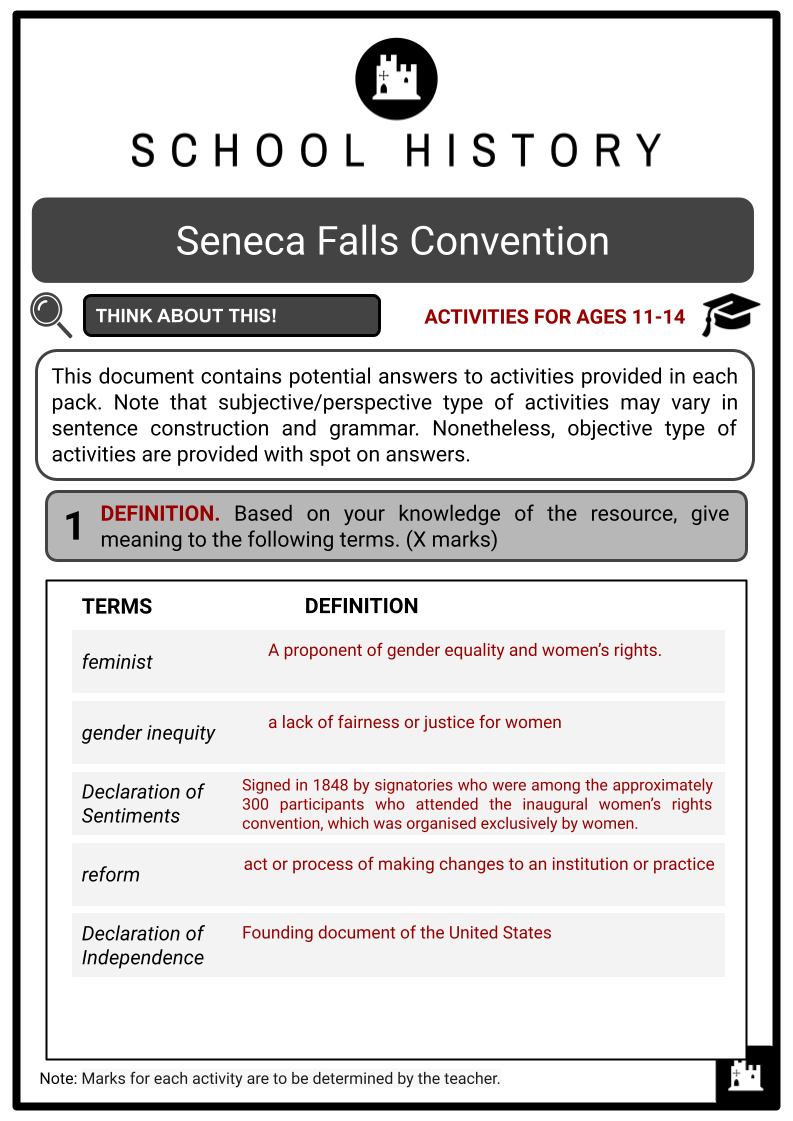
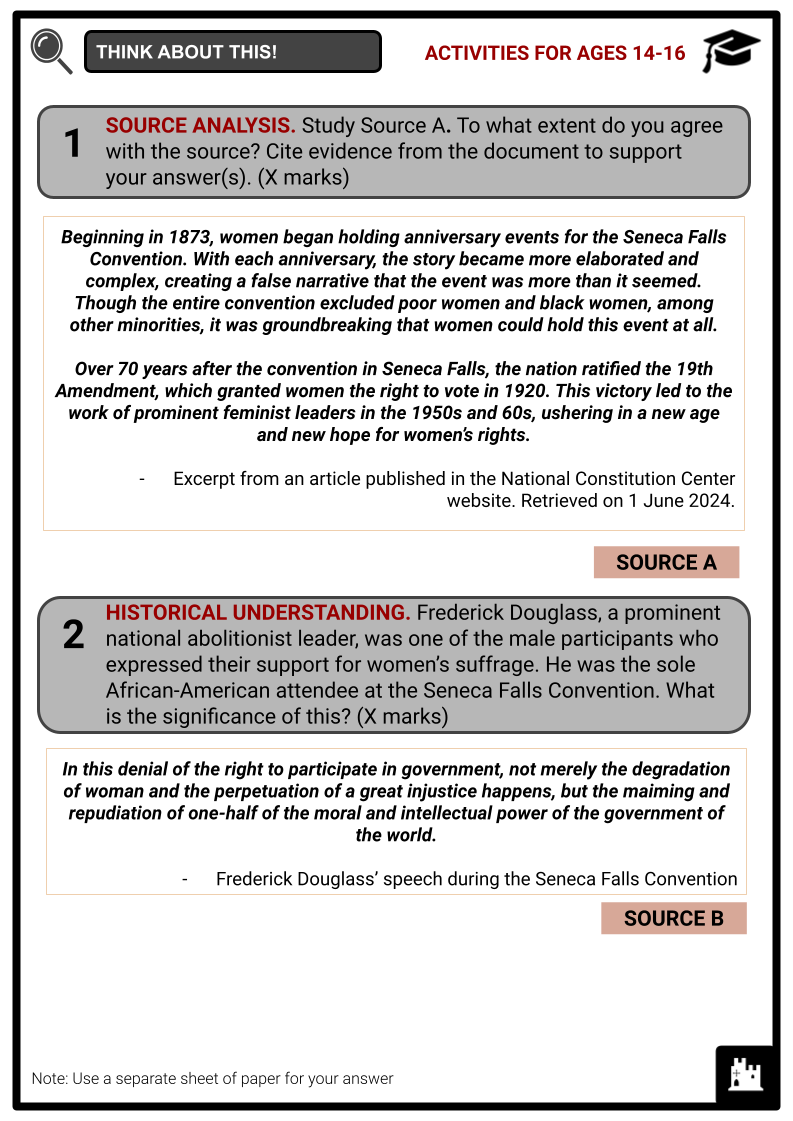
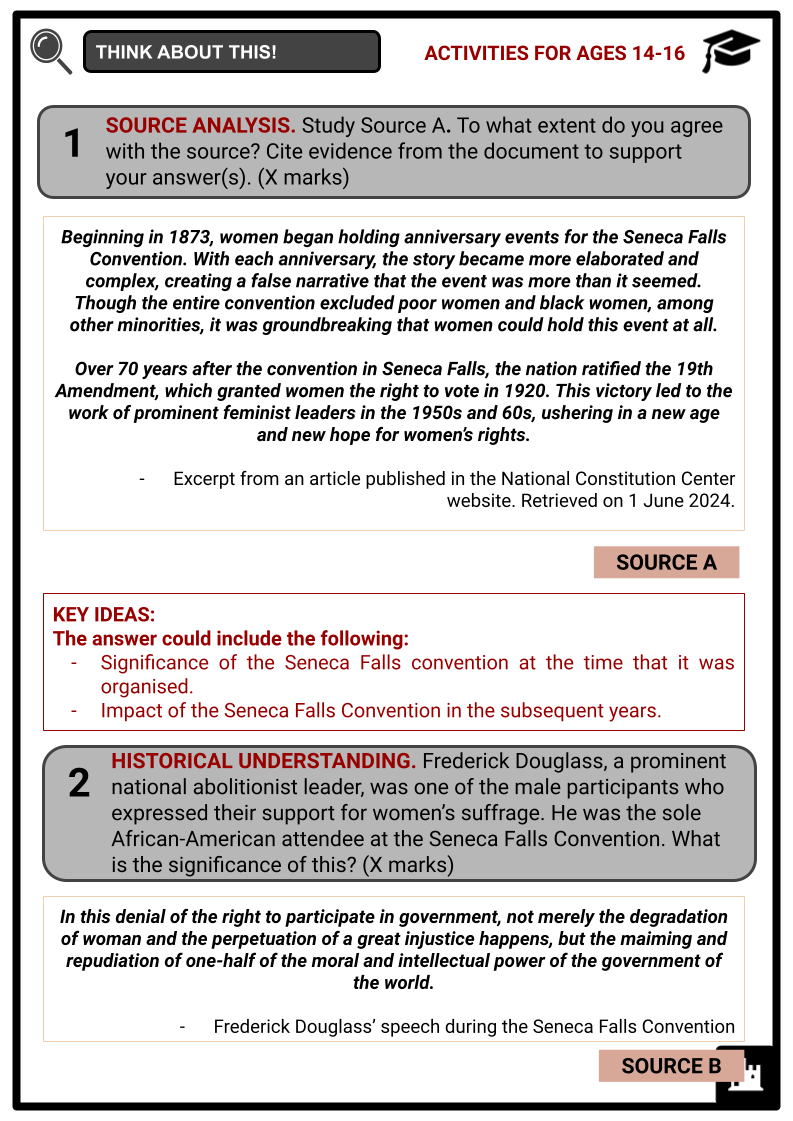
Summary
- Abolition to the Beginning of Women’s Rights
- Preparation for the Seneca Falls Convention
- Seneca Falls Convention
- Impact of the Seneca Falls Convention
Key Facts And Information
Let’s find out more about the Seneca Falls Convention!
The Seneca Falls Convention was the first convention that tackled women’s rights. The objective of the two-days Convention was to discuss the civil, social, and religious status of women in society. The Convention was held in the Wesleyan Chapel, Seneca Falls, New York and was attended by several prominent suffragists and abolitionists. Elizabeth Cady Stanton, Lucretia Mott, and female Quakers organised the Convention. Seneca Falls Convention inspired a lot of suffragists in organising conventions that focus on women’s rights.
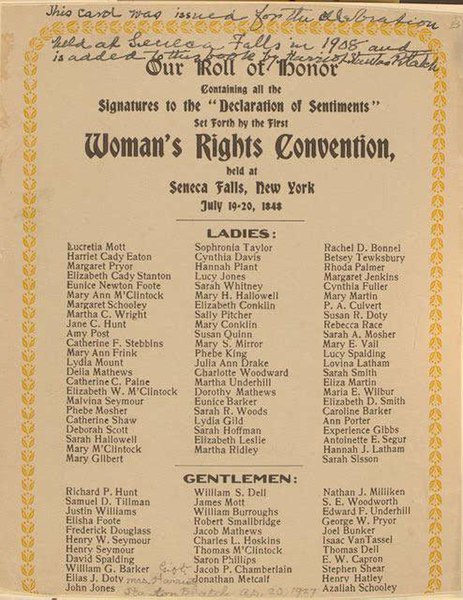
ABOLITION TO THE BEGINNING OF WOMEN’S RIGHTS
- Women played a prominent role in spearheading various antebellum reforms, including transcendentalism, temperance, and abolition. As women spearheaded these reforms, they acquired the political influence necessary to initiate the initial phase of feminism in the United States. Ironically, the religion of domesticity, which advocated for women to be confined to the home, paradoxically contributed to the promotion of women’s involvement in public movements.
- Women who advocated for temperance emphasised their position as moral protectors of the household to campaign against alcohol consumption. Several women advocated for a significantly broader role, which involved instructing both children and men in fundamental republican values, such as liberty and justice. The feminist movements in the early 19th century were strongly influenced by religion, particularly as a result of the spiritual revivals during the Second Great Awakening.
- However, it was the work in endeavours to abolish slavery that acted as a catalyst for women to initiate measures against gender disparity. Northern women, in particular, reached the realisation that they, similar to enslaved individuals, were confined and oppressed in a male-dominated society. Sarah and Angelina Grimké, prominent abolitionist women, significantly contributed to the integration of the anti-slavery movement with the pursuit of gender equality.
- The Grimké sisters were born into a wealthy family in South Carolina that owned enslaved people. Both individuals were deeply influenced by the intense religious enthusiasm of the Second Great Awakening, prompting them to go to the Northern region. In the mid-1830s, the sisters became part of the abolitionist movement. In 1837, they began a public lecture tour, where they advocated for the abolition of slavery to audiences consisting of both women and men.
- These gatherings were referred to as promiscuous assemblies. This public activity greatly shocked the respectable society, as it was unprecedented for women to give lectures to men. William Lloyd Garrison, the renowned editor of The Liberator, a prominent newspaper advocating for the abolition of slavery, supported the public lectures given by the Grimké sisters. However, not all abolitionists shared his endorsement. Their lecture tour marked a significant shift in public opinion, as the backlash against them brought the issue of women's appropriate role in society to the forefront of public discourse.
- In 1840, prompted by American abolitionists William Lloyd Garrison and Wendell Phillips, Lucretia Coffin Mott and Elizabeth Cady Stanton, along with their husbands and a group of American male and female abolitionists, travelled to London for the inaugural World’s Anti-Slavery Convention. They anticipated that the proposal made by Phillips to incorporate women’s involvement in the Convention would be met with controversy.
- During the Convention, there was intense deliberation on whether to allow women’s involvement; ultimately, it was rejected. They were allowed to observe from the gallery but not participate in discussions. On their way home, Stanton and Mott came up with the idea to organise their own Convention to discuss women’s rights.
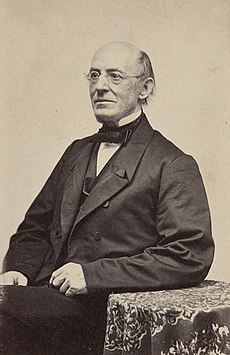
- During the 1840s, women’s lives were controlled by men (husbands and fathers), resulting in them actively seeking control over their lives. They were also excluded from many social opportunities, like owning property, having a job not limited to service-related industries, a fair salary, and participating in elections. Women were forbidden by state regulations and common law from inheriting property, signing contracts, serving on juries, and participating in elections.
- Mott and Stanton met in Boston to discuss the convention they were planning. In 1846, Mott and Paulina Wright Davis, an American educator, started organising public meetings in Philadelphia. A lot happened in 1847. Abolitionist groups supported the women’s movement in advancing the discussion on women’s rights. In the same year, Mott and Stanton met again to finalise the plans for the first-ever Convention of Women that solely focused on women’s rights, distinct from the abolitionists.
- The New York State Assembly approved the Married Woman’s Property Act on 7 April 1848 in response to a citizen’s petition. This act granted women the right to keep the property they owned before marriage and any property they obtained during the marriage. Creditors are legally prohibited from confiscating a wife’s assets to settle her husband’s outstanding debts. However, New York was not the trailblazer in this instance. In February 1839, Mississippi passed its Married Women’s Property Act, becoming the first state to grant married women the right to own and manage property independently.
PREPARATION FOR THE SENECA FALLS CONVENTION
- Many women who participated in the abolitionist movement also advocated for their own liberation, but they recognised that their struggle was not equivalent to that of African Americans during that period. Stanton, Mott, Lucy Stone, and Susan B. Anthony spearheaded the effort. In the 1840s, Elizabeth Cady Stanton was regarded as quite radical by the general public due to her proposition that women should be granted the right to vote.
- During the year 1848, over 300 feminists, both men and women, who had previously participated in the abolition struggle, convened at the Seneca Falls Convention in New York. The purpose of this Convention, which was arranged by Mott and Stanton, was to discuss women’s rights. It was the inaugural gathering of what later became a series of yearly gatherings that have persisted up until now.
- On 9 July 1848, Mott and her sister Martha Coffin Wright and some key suffragists decided to announce the upcoming Convention. The announcement began with the following words: “WOMAN’S RIGHTS CONVENTION.—A Convention to discuss the social, civil, and religious condition and rights of Woman”.
- The advertisement explicitly stated that the first day’s sessions on 19 July were exclusively for women, but both women and men were welcome to join on the second day to listen to Mott and other speakers. The announcement was initially made on 11 July, providing readers with a mere eight days’ warning till the commencement of the Convention. Additional publications, such as the North Star, published the message on 14 July.
- On 16 July, Stanton worked alone at her writing desk at home, editing the grievances and resolutions. Henry Brewster Stanton, a lawyer and husband of Stanton, contributed to the document’s validity by adding excerpts from laws that unfairly affected women’s rights. Stanton alone introduced a more extreme aspect to the catalogue of complaints and resolutions: women’s suffrage.
SENECA FALLS CONVENTION
- On 19 July 1848, the Convention started. Stanton began with the speech: “We are assembled to protest against a form of government, existing without the consent of the governed—to declare our right to be free as man is free, to be represented in the government which we are taxed to support, to have such disgraceful laws as give man the power to chastise and imprison his wife, to take the wages which she earns, the property which she inherits, and, in case of separation, the children of her love.”
- Despite the initial announcement that the first session was solely for women, their moms brought several young children of both genders, and approximately forty men were present. The men were not denied entry but were instructed to maintain silence. Stanton commenced her speech by urging every woman in the audience to assume accountability for her own life and to comprehend the magnitude of her degradation in terms of its height, depth, length, and breadth. After that, Mott addressed the audience, urging them all to support the cause.
- Stanton thoroughly read the Declaration of Rights and Sentiments or Declaration of Sentiments. Subsequently, each paragraph was reviewed to facilitate in-depth discussion and implement any necessary adjustments. The participants unanimously adopted a Declaration of Rights and Sentiments, drawing inspiration from the Declaration of Independence. The text asserts that throughout history, there has been a pattern of men inflicting harm and seizing power from women, with the explicit goal of establishing complete domination over them.
- The matter of whether men’s signatures would be requested for the Declaration was deliberated upon, and the vote appeared to be in favour of including males. However, the decision was postponed until the next day to allow men to join the discussion. The morning session commenced at 2:30 pm and resumed after a few minutes of break. Stanton read the Declaration of Sentiments again, and more changes were made to it. Stanton’s addition to the women’s suffrage was also discussed. In the evening, Mott spoke about the progress of other reform movements and contextualised her speech for the struggle for women’s rights. She asked the male participants to help them gain equality in the society.
- Due to Mott’s renown and ability to attract a large audience, some individuals at Seneca Falls arranged the Rochester Women’s Rights Convention in Rochester, New York, two weeks later. Mott was invited to be the main speaker at this event. In contrast to the Seneca Falls convention, the Rochester convention made the bold decision to appoint a woman, Abigail Bush, as its presiding officer.
- More people attended on the second day of the Convention, including Amelia Bloomer, an American newspaper editor and women’s rights and temperance advocate. Mott’s husband, James Mott, also attended the second day. Further discussion of the Declaration ensued, including comments from Frederick Douglass, the only African American to participate in the convention. Stanton asked the participants to support and pass her addition to the Declaration, which focuses on women’s suffrage. Many opposed the idea, including the Mott and her husband.
- Stanton defended the concept of woman suffrage, saying women could then affect future legislation and gain further rights. Douglass supported and advocated for women’s suffrage. In a short statement, he mentioned that he could not accept the right to vote if the same right would be denied to women. After Douglass’ statement, the participants passed the addition into a resolution. He also wrote an article in the North Star, emphasising the support needed for women’s suffrage. Douglass also narrated the important events during the Seneca Falls Convention.
- During the morning session, the question of whether to include or not the men’s signature was addressed. One hundred out of three participants–sixty-eight women and thirty-two men signed the Declaration of Sentiments.
- During the morning session, the question of whether to include or not the men’s signature was addressed. One hundred out of three participants–sixty-eight women and thirty-two men signed the Declaration of Sentiments. Mott thanked Stanton and the rest of the organisers during her speech. To conclude the meeting, a committee was established to revise and publish the convention proceedings. This committee comprised Amy Post, Eunice Newton Foote, Mary Ann M’Clintock, Elizabeth W. M’Clintock, and Stanton.
- Although several pastors leading congregations in the area were present at the Seneca Falls Convention, none of them spoke their opinions during the sessions, even when there was an opportunity for remarks from the attendees. On Sunday, 23 July, a multitude of individuals, both present and absent, launched an assault on the Convention, the Declaration of Sentiments, and the resolutions.
- Female members of the congregations reported to Stanton, who viewed the ministers’ behaviour as cowardly. In these congregations, no one was permitted to respond. The signatories of the Declaration of Sentiments expressed their desire for subsequent conventions to be held throughout the entire country.
- In 1948, a commemorative stamp was released to honour the Seneca Falls Convention. The stamp showcased prominent figures Stanton, Carrie Chapman Catt, and Mott as part of the Centennial Celebration held in Seneca Falls. The establishment of the Women’s Rights National Historical Park took place in 1980.
IMPACT OF THE SENECA FALLS CONVENTION
- A number of female reformers from the northern regions recognised the potential for their gender to play significant and essential roles in the field of education. They held the belief in conventional gender roles, perceiving women as essentially possessing greater moral and nurturing qualities compared to men. The feminists contended that due to these characteristics, women possessed distinct qualifications to assume the responsibilities of educating children.
- The genesis of this concept may be traced back to the late 1700s, however, it was formalised and garnered significant backing during the mid-1800s, coinciding with the emergence of the initial women’s rights movement. The religious revival and reform movement during the pre-Civil War era had a profound influence on women, enabling them to contemplate their lives and society from fresh and liberating perspectives.
- While the initial stage of American feminism did not result in instant political rights for women, it initiated the gradual process of addressing and resolving gender inequity in the United States. However, this progress was overshadowed by the focus on the abolitionist movement throughout the mid-19th century.
Frequently Asked Questions
- What was the Seneca Falls Convention?
The Seneca Falls Convention was the first women's rights convention in the United States, held from 19 July to 20 August 1848 in Seneca Falls, New York. It marked the beginning of the organised women's rights movement in the United States.
- Who organised the Seneca Falls Convention?
Elizabeth Cady Stanton, Lucretia Mott, Martha Wright, Mary Ann M'Clintock, and Jane Hunt, organised the convention. These women were motivated by their experiences with gender discrimination and involvement in the abolitionist movement.
- What significant document was produced at the Seneca Falls Convention?
The convention produced the "Declaration of Sentiments," a document modelled after the Declaration of Independence that outlined the injustices faced by women and called for equal rights, including the right to vote
